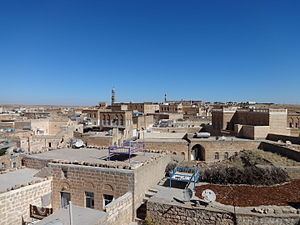Website www.midyat.bel.tr | Post code 47500 | |
 | ||
Turkey midyat mardin part 14
Midyat (Kurdish: Midyad, Syriac: ܡܕܝܕ Mëḏyaḏ or Miḏyôyo in the local Turoyo dialect, Arabic: مديات) is a town in Mardin Province of Turkey. The ancient city is the center of a centuries-old Hurrian/Hurrian town in Southeast-Turkey, widely familiar under its Syriac name Tur Abdin. A cognate of the name Midyat is first encountered in an inscription of the Assyrian king Ashur-nasir-pal II (883-859 B.C.). This royal text depicts how forces conquered the city and its surrounding villages. In its long history, the city of Midyat has been ruled by various different leaders and nations.
Contents
- Turkey midyat mardin part 14
- Map of Midyat Mardin Turkey
- Turkey mardin midyat part 13
- History
- Geography
- Quarters
- Economy
- Climate
- References
Map of Midyat, Mardin, Turkey
Turkey mardin midyat part 13
History
The history of Midyat can be traced back to the Hurrians during the 3rd millennium. Ninth century BC Assyrian tablets refer to Midyat as Matiate, or city of caves due to the caves at eleth 3 km away from the city where the earliest inhabitants lived. Many different empires had ruled over Midyat including the Mitannians, Assyrians, Armenians, Medes, Persians, Greeks, Romans, Byzantines, Abbasids, Seljuks and Ottomans.
Midyat is a historic center of the Assyrians in Turkey, and as late as the Syriac Genocide the 1915 took up a majority in the city. During the early 20th century, The Syriac population of the city started to gradually diminish from immigration, but the community was still very large. The Assyrians of Tur Abdin were the only significant population of Christians outside of Istanbul, until 1979, when panic overtook the still Syriac city, because the mayor, a major Syriac figure in the City of kerboran, now named [Dargecit]] was assassinated and replaced with a Kurdish representative. The Syriacs up until then had control over the local government, and could therefore unify and have power in the case of threats. Soon after the takeover, local Mhallami and Kurdish inhabitants started immigrating into the traditionally Syriac areas, causing a demographic imbalance and, along with the start of the Turkey-PKK conflict a few years later in 1984, sounded a death blow to the community not only here, but in all of Tur Abdin. From a population in 1975 of 50,000, taking up 10% of Mardin provinces demographic barely 2,000 were left by the end of the conflict in 1999. Now only around 3-5,000 live in Tur Abdin, with the other 15-17,000 living in Istanbul.
The churches and houses belonging to the Christians have been preserved although many of them are empty, with their owners living away in Europe. At present some 130 Syriac Christians families continue to live in Midyat permanently, and they have been joined by at least 300 Syrian refugees fleeing the Syrian Civil War. There are 5 Churches in the city, and all are Syriac.
Geography
The City has many distinguishable features which can make it easy to tell which areas are which. The city of Midyat is in fact two settlements- one to the east and one to the west. This is noticeable even today as the two old towns, and their clustered street plans, are very far apart, therefore showing that later on the area was connected to form a single united city when more buildings were built in between the two old towns. The Assyrian part of the city is in the east and the part of the city they live is distinguishable by the amount of older buildings, churches, and deterioration due to abandonment. Many buildings in the old towns are also distinguishable due to their ornate patterns and use of Midyat Limestone, although it is also used in a few of the newer buildings outside of the old town too. The Kurdish and Mhallami populated parts of the city are all of the buildings to the west of the Assyrian old town(which is the one that lies east). The entire region is divided East-West along those lines in fact, with most of the remaining Assyrian villages in Tur Abdin being no further west then Midyat is.
Quarters
During the late Ottoman period the city was divided up into different districts, still used in modern times. Old Midyat was divided into the following quarters (written in Syriac using the Latin alphabet: Aš šawṯawoṯo d Mëḏyaḏ):
Economy
Midyat is the regional center of commerce for the district, and is one of the largest cities in Mardin Province. Similarly with Mardin, The City is known for its Syriac handicrafts such as carpets, towels and other cloth goods. More specific to the city is its Syriac silver crafts called telkari, which are handcrafted filigreed ornaments. To the east of the city there is a winery that makes traditional Syriac wine: a wine native to the region. Another staple in the Midyat market is its bulgur, which is a cereal food derived from wheat. Tourism in Midyat, however dwarfed it may be compared to Mardin, is still an important part of the economy as well, having several world class hotels such as the Schmayaa, Turabdin, Midyat, and Kasr-i Nehroz hotels.
Climate
Midyat part of the province of Mardin has a semi-arid climate with very hot and dry summers and cold, wet, and occasionally snowy winters. Temperatures in summer usually increase to 40 °C - 50 °C (104 °F - 122 °F) due to Mardin being situated right next to the border of Syria. Snowfall is quite common between the months of December and March, snowing for a week or two. Mardin has over 3000 hours of sun per year. The highest recorded temperature is +48.8 °C.
References:
Bargello, Fehmi, Min hemstad Midyat. Linköping: 2015.
Bargello, Fehmi, I flyktens kölvatten. Jönköping: 1998.
Hollerweger, Hans, Turabdin. Austria: 1999.
